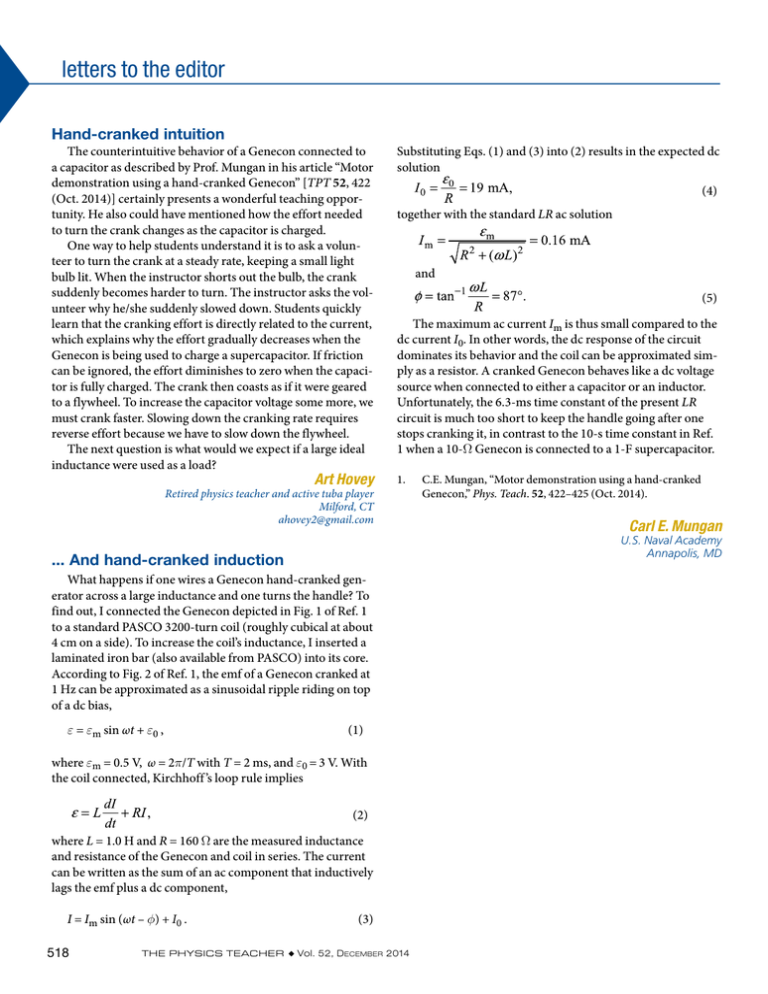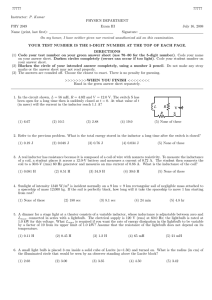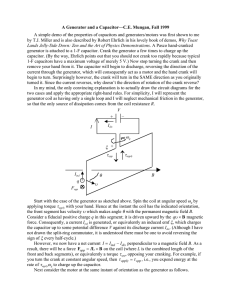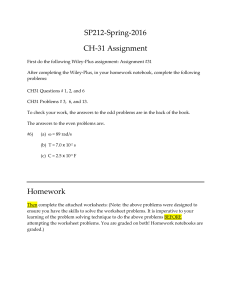letters to the editor Hand-cranked intuition
advertisement

letters to the editor Hand-cranked intuition The counterintuitive behavior of a Genecon connected to a capacitor as described by Prof. Mungan in his article “Motor demonstration using a hand-cranked Genecon” [TPT 52, 422 (Oct. 2014)] certainly presents a wonderful teaching opportunity. He also could have mentioned how the effort needed to turn the crank changes as the capacitor is charged. One way to help students understand it is to ask a volunteer to turn the crank at a steady rate, keeping a small light bulb lit. When the instructor shorts out the bulb, the crank suddenly becomes harder to turn. The instructor asks the volunteer why he/she suddenly slowed down. Students quickly learn that the cranking effort is directly related to the current, which explains why the effort gradually decreases when the Genecon is being used to charge a supercapacitor. If friction can be ignored, the effort diminishes to zero when the capacitor is fully charged. The crank then coasts as if it were geared to a flywheel. To increase the capacitor voltage some more, we must crank faster. Slowing down the cranking rate requires reverse effort because we have to slow down the flywheel. The next question is what would we expect if a large ideal inductance were used as a load? Art Hovey Retired physics teacher and active tuba player Milford, CT ahovey2@gmail.com Substituting Eqs. (1) and (3) into (2) results in the expected dc solution (4) together with the standard LR ac solution and (5) The maximum ac current Im is thus small compared to the dc current I0. In other words, the dc response of the circuit dominates its behavior and the coil can be approximated simply as a resistor. A cranked Genecon behaves like a dc voltage source when connected to either a capacitor or an inductor. Unfortunately, the 6.3-ms time constant of the present LR circuit is much too short to keep the handle going after one stops cranking it, in contrast to the 10-s time constant in Ref. 1 when a 10-W Genecon is connected to a 1-F supercapacitor. 1. What happens if one wires a Genecon hand-cranked generator across a large inductance and one turns the handle? To find out, I connected the Genecon depicted in Fig. 1 of Ref. 1 to a standard PASCO 3200-turn coil (roughly cubical at about 4 cm on a side). To increase the coil’s inductance, I inserted a laminated iron bar (also available from PASCO) into its core. According to Fig. 2 of Ref. 1, the emf of a Genecon cranked at 1 Hz can be approximated as a sinusoidal ripple riding on top of a dc bias, (1) where em = 0.5 V, ω = 2p/T with T = 2 ms, and e0 = 3 V. With the coil connected, Kirchhoff ’s loop rule implies (2) where L = 1.0 H and R = 160 W are the measured inductance and resistance of the Genecon and coil in series. The current can be written as the sum of an ac component that inductively lags the emf plus a dc component, I = Im sin (ωt – f) + I0 . 518 C.E. Mungan, “Motor demonstration using a hand-cranked Genecon,” Phys. Teach. 52, 422–425 (Oct. 2014). Carl E. Mungan U.S. Naval Academy Annapolis, MD ... And hand-cranked induction e = em sin ωt + e0 , (3) Revisiting smartphone astronomy In the article “Smartphone astronomy” on p. 440 of the October 2014 issue of The Physics Teacher,1 the authors describe a simple method to determine the velocity of the ISS using a smartphone. To do this, they propose a formula (1) linking this velocity to the apparent angular velocity of the satellite. Unfortunately there must be an error, for when one tries to use the formula with the suggested values, one gets a velocity about 15 times too large. However, in my opinion, the formula is right provided: • The angular velocity ω is measured when the satellite is closest to the observer (during a short moment it then moves perpendicularly to the direction of observation). If it is measured when the ISS is at 45° from the closest point, the calculated angular velocity is about 30% too small. • Most important: hISS is the distance between the observer and the ISS (not the distance between the ISS and the center of the Earth, as shown in Fig. 1 and alluded to in the text). hISS corresponds to the height relative to the surface of the Earth only if the ISS passes vertically above The Physics Teacher ◆ Vol. 52, December 2014






